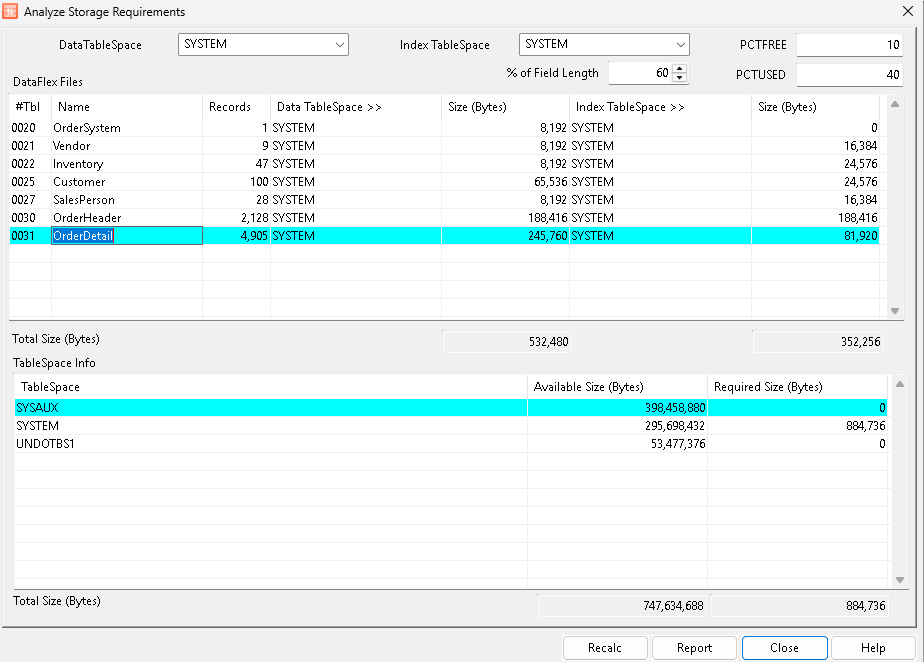Analyze Storage Requirements¶
How To Access
With ORAFlex 2.0, Mertech introduced a very important enhancement to the Flex2SQL utility regarding Oracle storage calculations. Before performing an Oracle data migration, you can analyze the Oracle storage requirements and determine if the Oracle tablespaces have sufficient room.

You can choose different tablespaces for index and data tables, as well as, assign individual tables to different tablespaces. Flex2SQL dynamically calculates the storage requirement for each table. If the tablespace is not sufficient, the calculation is highlighted in RED. Use Oracle’s Storage Manager utility to increase tablespace sizes.
There are two values that must be set before proceeding with the analysis of storage requirements. These two settings deal with the differences between Oracle and DataFlex record lengths. The two settings are Use Storage Clause (which includes the % filled for large fields) and Number of Records to be used for Empty Files. These settings are entered in the Oracle Tab of the Convert Dat to Table dialog box.
TableSpace Selection Lists¶
The tablespace selection lists at the top of the Analyze Storage Requirements dialog box are used to select the default Oracle tablespaces for the migrated data and index tables.
Data TableSpace: The tablespace that will contain data tables. It is advisable that index and data tables be created on two separate tablespaces, residing on different hard drives.
Index TableSpace: The tablespace where the index files will be created.
PCTFREE: Specifies the space reserved in each of the cluster’s data blocks for future expansion. The value of the parameter is expressed as a whole number and interpreted as a percentage.
PCTUSED: Specifies the limit that Oracle uses to determine when additional rows can be added to a cluster’s data block. The value of this parameter is expressed as a whole number and interpreted as a percentage.
% of Field Length: DataFlex text and binary fields have to be allocated a “fill” factor indicating what percentage of the DataFlex field size should be used in calculating the table size. This is because DataFlex has a fixed length field size for binary and text fields and Oracle uses a variable length field type. For example, if you have a 4K field size, but expect that most records will contain 1K of data, you should use 25% as the fill factor. This does not affect the length of the field but only the storage calculation.
DataFlex Files¶
The DataFlex files grid displays information for the selected DataFlex files.
Name: Name of the DataFlex file.
Records: Number of records in the DataFlex file.
Data TableSpace: The tablespace name for the migrated DataFlex file. To change the tablespace, click the Data TableSpace >> column heading to show the Table Space List dialog.
Size (Bytes): The required number of bytes for the migrated table.
Index TableSpace: The tablespace name where the indexes will be created.
Size (Bytes): The required number of bytes for the migrated indexes.
Total Size (Bytes): The total size required on the server side for all the DataFlex files displayed in the grid.
TableSpace Info¶
Displays size information for all the tablespaces the current user can access.
TableSpace: The name used to identify the tablespace.
Available Space (Bytes): The available space on the server.
Required Size (Bytes): The space required by the selected DataFlex tables. Turns red if the required size is larger than the available space.
Total Size (Bytes): The total available space and required space on the server for all DataFlex files and indexes.
Note
Only users with SELECT ANY TABLE rights or DBA rights have access to this feature. Consult your Oracle Enterprise Manager manual for more details.
